Fixing The Frome
Thirty years ago, heavy diggers were driven to the edge of the River Frome, just downstream of Dorchester, to excavate the banks and scoop out the riverbed, in order to make the river deeper and straighter. Now, the diggers have once returned to the exact same stretch of the Frome to fill it all back in again.
Standing on the bank of the Frome, among the recent scars and troughs of heavy plant machinery, John Aplin, river keeper and restorer, explains why his club, the Dorchester Fishing Club, is undoing all the hard work that went on three decades ago.
‘It was all done in the name of flood relief,’ explains John. ‘The river below Dorchester was canalised; dug into a uniform U-profile for a few miles, so that more water could flow and so reduce the risk of the river backing-up to flood the town.’
You might be forgiven for assuming that in these days of global warming and scary flash flood warnings, this kind of flood relief is more necessary than ever. But, as John explained, water and flood management is still in its infancy and still very much a case of trial, error and experimentation. The error that engineers made in the 1970s was to see flood relief as a function of just the river itself, rather than in conjunction with the huge network of water meadows that spread for miles on either side of the river corridor.
Farming practices changed in the 60s and 70s; the water meadow sluice gates and hatches were allowed to fall into disrepair; the tradition of flooding meadows, to warm the soil in preparation for a second crop each year, was abandoned. As the meadows were used less, the water – rather than being leached-out to feed the network of meadows and channels – remained within the river course itself. Not surprisingly, the river couldn’t cope with such a massive increase in volume being forced between its banks. And so ‘canalising’ rivers became the accepted method of dealing with extra flow. By taking out all the interesting kinks and bends and shallows in the river, engineers encouraged more water to pass through.
‘Of course, it was hopeless for fish,’ says John. ‘It was just one big uniform glide with nowhere for young fish to hide and absolutely no shallow gravel redds for fish to spawn into.’
With financial help from English Nature and the Environment Agency, survey help from the Dorset Wildlife Trust and practical expertise from fisheries specialists Kingcombe Aquacare , John ordered 200 tons of local gravel to be delivered and dumped into the river.
The three sites they chose to deposit the gravel are destined to become active redds on which trout, salmon and sea trout will spawn, as early as next month. The huge gravel deposits create shallow sections of river, where it flows quicker over the stones. This extra flow increases oxygen levels and helps to wash away any silt deposit which might otherwise suffocate fish eggs. Adding these three gravel sites has more than doubled the amount of potential spawning sites downstream of Dorchester. 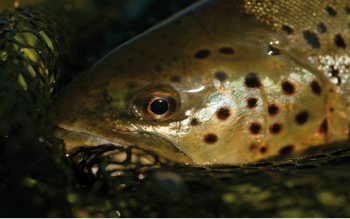
But John’s labours don’t just increase spawning redds. ‘We want riffles, glides, pools and back eddies,’ he says. ‘We want it all. We want to create variation and improve habitat, not just in the water but on the bankside too. We’ve customised steep banks to encourage the local water vole population; we’ve made new habitat for kingfishers and other birds. And all of this has happened because we love our fishing and love this river. Really, without fishermen, none of this would ever get done.’
Since the whole of the Frome valley was declared a Special Site of Scientific Interest, much has been done to improve the river. Many water meadows have been reopened and repaired, which now means many function as intended and help regulate flow and any potential flood. It hasn’t all been easy though. ‘Many of the old school river owners, the retired colonels and majors, were up in arms at the thought of all these university graduates and boffins getting their hands on the river,’ explains John, whose job it was to mediate between the two camps.
The range of improvements that were needed were many and varied, from putting in groynes, or upstream deflectors, to increase flow at strategic positions, to paying local farmers not to grow maize alongside the river. This is done to reduce the amount of top soil run-off that occurs in the autumn, after the maize harvest. A badly situated maize field can cause a vast amount of silt and dissolved mud entering the river and clogging the spawning. John is the first to admit that, much of the time, river restoration is guesswork. ‘We’re all of us on a steep learning curve,’ he explains. ‘We’ve made mistakes and hopefully we’ve learned from them. But at the end of the day, Nature always knows best, and it’s a wise man who listens.’
A river is a living thing, with a mind and a will of its own. Many people who work in restoration have discovered that you can only manhandle and manipulate Nature so far. ‘It sounds weird, I know,’ says John, ‘but a river responds to your respect, and even your love. Of course, you can force it to do something. We have the technology. Or, you can see what the river wants to do. The sites we’ve picked to locate the gravel redds were really dictated by the river. It’s like it knows where these would work best. All we had to do was listen.’
For John Aplin, the work he’s overseeing on the Frome is payback for all the pleasure the river has given him over the years. He moved to Dorchester aged 5 and soon started fishing the Frome. By the time he left school, he knew he wanted to be a river keeper, and has done it with great enthusiasm for the last 22 years. ‘To be working on the bit of river I grew up on and loved so much, makes me a very happy man,’ he said. ‘One of the things that makes me most happy is to see the enjoyment that our work brings to the quality of our members’ fishing.’
Brown trout sits at the top of the food chain in a river like the Frome. If you can keep brown trout healthy and growing well in a river system, then you know that the other end of the food chain is working properly. ‘Look after the bottom end of the food chain,’ says John, ‘the invertebrates, shrimps and insect life. Keep them happy and the trout will take care of themselves.’
To find out more about river restoration, contact the Dorchester Fishing Club (www.grhe.co.uk) or Casterbridge Fisheries Management on 07889 680464 (www.riverworks.co.uk) or Kingcombe Aquacare on 01460 279200.

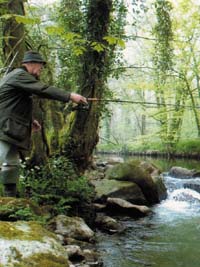
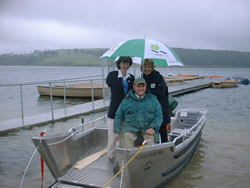
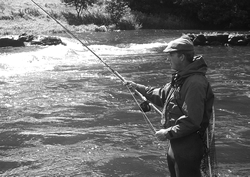 Salmon fishing in the westcountry is like no other place on earth. Many river valleys that have evolved over millions of years descend from the highest of Tors across the moors toward the Atlantic and the English Channel, each cutting deep scars through the hidden countryside and providing some of the most rugged yet the most enchanting fishing one can imagine. Others flow unhurriedly through lowland farmland that by their nature produce a much richer flora and fauna than can be found anywhere in England.
Salmon fishing in the westcountry is like no other place on earth. Many river valleys that have evolved over millions of years descend from the highest of Tors across the moors toward the Atlantic and the English Channel, each cutting deep scars through the hidden countryside and providing some of the most rugged yet the most enchanting fishing one can imagine. Others flow unhurriedly through lowland farmland that by their nature produce a much richer flora and fauna than can be found anywhere in England.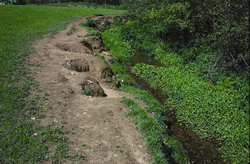 The Westcountry Rivers Trust is an environmentally charity established in 1995 to secure the preservation, protection, development and improvement of rivers, streams and watercourses in the Westcountry and to advance the education of the public in the management of water.
The Westcountry Rivers Trust is an environmentally charity established in 1995 to secure the preservation, protection, development and improvement of rivers, streams and watercourses in the Westcountry and to advance the education of the public in the management of water.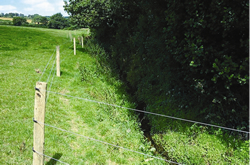 These lofty undertakings may not, at first sight, seem relevant to the Westcountry but the causes of these problems are often found far away and it is part of the Trusts ethos to tackle problems at their source rather than trying to manage the symptoms.
These lofty undertakings may not, at first sight, seem relevant to the Westcountry but the causes of these problems are often found far away and it is part of the Trusts ethos to tackle problems at their source rather than trying to manage the symptoms.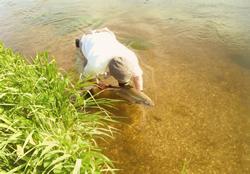 The southern, lowland chalk streams of Wessex have a rich bio-diversity that has, for millennia, supported thriving populations of fish, flora, birds and invertebrates. Foremost among these is the famous River Hampshire Avon. Rising from the chalk aquifer of Salisbury Plain as the East and West Avon, it heads south for Salisbury where it is joined by the Rivers Bourne, Wylie, Nadder and Ebble, each offering individual characteristics and angling opportunities whilst hosting the catchment’s spawning salmon. These revered centres of trout fishing, and on the Nadder coarse angling as well, set the standard for the main river that runs from Britford through Hampshire to the sea at Christchurch in Dorset, briefly meeting with the River Stour, from the west.
The southern, lowland chalk streams of Wessex have a rich bio-diversity that has, for millennia, supported thriving populations of fish, flora, birds and invertebrates. Foremost among these is the famous River Hampshire Avon. Rising from the chalk aquifer of Salisbury Plain as the East and West Avon, it heads south for Salisbury where it is joined by the Rivers Bourne, Wylie, Nadder and Ebble, each offering individual characteristics and angling opportunities whilst hosting the catchment’s spawning salmon. These revered centres of trout fishing, and on the Nadder coarse angling as well, set the standard for the main river that runs from Britford through Hampshire to the sea at Christchurch in Dorset, briefly meeting with the River Stour, from the west.